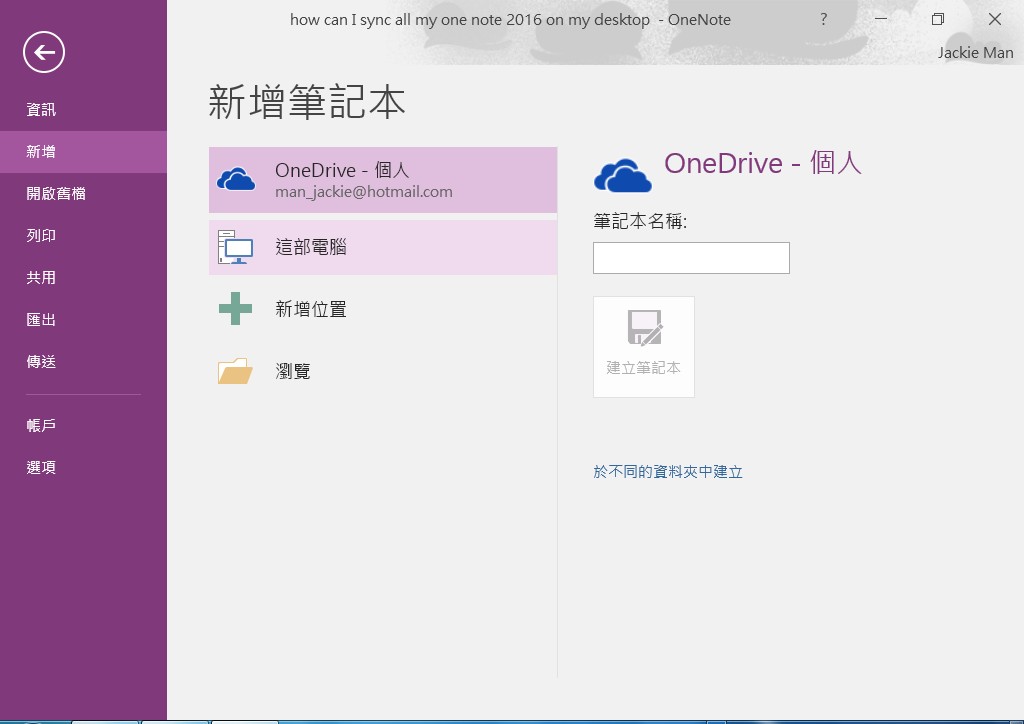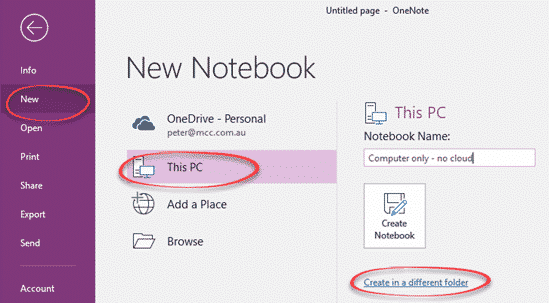Microsoft held their annual Ignite conference last week and I was fortunate to be able to attend this year. One of the coolest features (cool is relative) that was teased is the ability for the OneDrive sync client to automatically import OneNote notebooks into OneDrive. The current behavior is not ideal, if you enable PC Folder Backup (Formerly Known Folder Move), the UI tells you that you must manually move your OneNote notebooks into OneDrive using OneNote before allowing you to turn on the backup and gives a link to an article that doesn’t do a great job of explaining exactly what to do. Alternatively, if you move your .one and .onetoc2 files into a folder your syncing with OneDrive using File Explorer the next time you open the notebook there will be a good chance that you’ll see an error across the top of OneNote that says something to the effect of “your notebook is in archival format”. Not great.
- To move a notebook to OneDrive if you originally created the notebook on your computer, do the following: In OneNote 2016 or OneNote 2013, open the notebook that you want to share on OneDrive. Select File Share. Select a location for your notebook, or select Add a Place, and then sign into your.
- We would like to show you a description here but the site won’t allow us.
- Note: Exporting and importing notebooks through OneNote for the web is only available for notebooks stored on personal OneDrive accounts, not for notebooks stored on OneDrive for Business or SharePoint. For information about exporting notebooks to PDF files from OneNote 2016 for Windows, see Export notes from OneNote as a PDF.
Microsoft OneNote The digital note-taking app for your.
OneNote auto import (I’m not sure if this feature has an official name, I’ll call it OneNote auto import for now) to the rescue! In the session BRK3262: Microsoft OneDrive deployment and adoption deep-dive Gaia Carini demonstrates the new OneNote auto import feature. She mentions that the feature is coming to insiders soon and will be rolled out to the production ring by the end of 2019.
But I was curious as to which version of the OneDrive sync client supports the feature so I tested some things out. Fist I checked which version of the OneDrive sync client I have, I’m in the insiders ring and as of 11/11/2019 I’m on version 19.192.0926.0011.
To test I stopped the OneDrive sync client then using OneNote 2016 I created a new notebook called “OneNote to OneDrive Notebook Move”, as you see in the screenshot below the notebook is stored at C:UsersDanie|OneDriveDocumentsTestingOneNote to OneDrive Notebook Move, note this is stored in a personal OneDrive account, not a OneDrive for Business account.
I started the OneDrive sync client again to see if the feature works… it didn’t. The .one and .onetoc2 files were copied up to OneDrive but the OneNote auto import experience did not occur.
Well that was lackluster, but then I thought what if I try it with a OneDrive for Business account (as opposed to a OneDrive personal account)? I shut down the OneDrive sync client again, then using OneNote 2016, I moved the notebook to a folder that I’m syncing to my OneDrive for business account, my new local path for the notebook is C:UsersDanieOneDrive - Dan LetsingerDocumentsOneNote Notebooks.
I started the OneDrive sync client and saw the magic happen immediately. The .one and .onetoc2 files were uploaded to OneDrive and the local files were removed.

To be sure, I opened OneNote 2016 and I see that the OneNote notebook is now syncing to my OneDrive for Business account.
Conclusion
It appears that if you have the OneDrive sync client 19.192.0926.0011 (or newer I’m assuming) and you’re syncing a OneDrive for Business account that OneNote auto import will migrate your OneNote notebooks without requiring you to take extra steps.
Almost all existing OneNote versions require your notebooks to be stored in a Microsoft cloud service, namely OneDrive or OneDrive for Business. Is there a way to bypass that restriction?


If you do not want to (or are not allowed to) store your OneNote notebooks in a public cloud service, I have a lot of bad and only one good news for you. Let me start with the good one: The OneNote version for Windows that is installed with MS Office (2010, 2013, 2016) lets you freely choose the storage location for your notebook files. So you can keep them on a local drive or a network share inside your organization. An alternative would be an on-premise Sharepoint server, which also works rather well at least with OneNote 2016 for Windows and OneNote Online (in the browser). You can even share those notes with other users or devices (as long as they run the Office version of OneNote for Windows) if you set the proper access rights to the SharePoint library or network share.
Now for the bad news. All other OneNote versions, so OneNote for MacOS, iOS, Android, Windows 8/10 mobile, OneNote Online and the Windows 10 app, require your notebooks to be stored on a cloud service by Microsoft. This can be OneDrive (personal) or OneDrive for business (aka Sharepoint Online, part of some Office 365 subscriptions). You can’t even switch to another cloud service like Dropbox or Google Drive, because those don’t support the protocol needed for a correct note synchronization. More detail about this in this article.
Onenote Online
So if you are reading this article hoping for a workaround to use any OneNote app without a Microsoft account, an Office 365 subscription and OneDrive, I am sorry to disappoint you. I wrote this mainly to confirm that there is absolutely no way around these prerequisites.
But what about all OneNote apps being able to work offline?
Apparently, you can edit existing notes or add new ones without an active internet connection on any OneNote app and system. So the notes must be stored on the device, right? Yes, they are. But this offline cache is in a special format (binary files, all very split up) and only used by OneNote to temporary work with a copy to synchronize the content with the actual storage location later, when an internet connection is re-established.
Now it could come to your mind to create a notebook on OneDrive (notebooks can’t be created on your device while it is offline), open it on your Mac or iPad, delete the original file from OneDrive using your browser and from then on only work in that cached local copy. Yes, you could do that and the only obvious drawback would be a constant sync error that you could just ignore. But I strongly advise against that method, because that cached copy is rather fragile. Closing a notebook, resetting your OneNote settings or probably an upcoming app update will erase the local cache and delete all your notes without any recovery options.
So the point is: If you want to use OneNote on Mac, iOS, Android, Windows 10 mobile or the Windows 10 UWP app, you have to store your notebooks on OneDrive or OneDrive for Business. Again, sorry if this is bad news.

Why is Microsoft doing this?
Well, if you ask any Microsoft representative, the usual answer is: “Because the cloud is better, safer and more reliable than any local drive”. I consider that half of the truth at best and mostly marketing twaddle. But I am sure that there are two real reasons. One is merely political. In 2014 Microsoft CEO Satya Nadella declared a change of course and that the future of Microsoft (products) would now lie in “Cloud first, mobile first”. Forcing OneNote users to the Microsoft cloud services is just a consequence of this new directive.
Onenote Onedrive
The second reason is of a technical nature. Because of the way how OneNote synchronizes data (only updating changes to single objects inside a file instead of the whole file), a special protocol is needed. This is called COBALT or MS-FSHTTP by Microsoft and is only supported by Sharepoint and OneDrive. Even locally stored notebooks (with OneNote for Windows/desktop only) are handled in a way that is close to that COBALT protocol. I bet this could not be easily reproduced on the MacOS or iOS file systems. And given the first reason, it is very unlikely that Microsoft would put any effort in it.
Will Microsoft change their mind?
Who can say that? And if they will, will they change it in the “right” direction or maybe also remove the option to store notebooks locally from OneNote for Windows. Or completely remove the desktop version of OneNote (with Office 2019?), only leaving the Windows 10 app. But you can still try to add your vote for local storage to come on the Uservoice foums for OneNote for Mac, OneNote for iOS, Android or the Windows 10 app.
